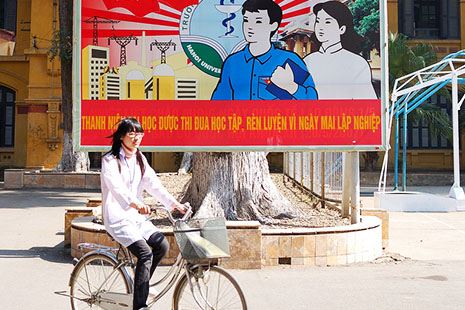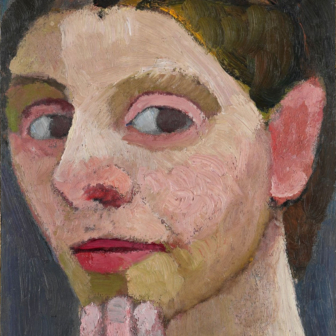MAI is twenty-eight and married to a medical practitioner, with whom she has a young daughter. Their apartment in a fashionable part of Hanoi is smartly furnished; Mai is fluent in English and has a PhD in sociology from the Australian National University. On paper, she has everything going for her in a country hungry for both education and English speakers. But behind the confident appearance and serene smile, Mai is deeply unhappy – and her unhappiness is by no means uncommon in modernising, bustling Vietnam.
“My husband doesn’t want an educated wife with a career; he wants a housewife,” she says quietly, her eyes lowered. “All the time I was working on my thesis, away from my home and my child, I cried and cried. All I can remember now is the crying and the sadness. I think now it will always be there.”
Why the tears? Mai takes a deep breath and looks to the sky. There is a long pause. “You know, not once did he ever ask me about my thesis. Never. Not a word. It was as though this part of my life was invisible to him. He didn’t want to know about it, and still doesn’t.”
Hanh is thirty, with a Masters degree from an elite US university; she has a part-time job lecturing in business studies in Hanoi, and wants to pursue a long-term academic career.
“My family never talks to me about my work,” she says, “only the fact that I am still single. It is all they think about, the only topic of conversation.” Hanh says she despairs of meeting a man who respects her career options. “The men I have met, also educated and career-minded, have made it very clear to me that what they are looking for is a housekeeper and a mother, not an equal partner, and what I am hearing from my own family merely reinforces this.”
Kim-Ly, twenty-eight, finds life easier, but she has reservations about changing perceptions of gender roles. A fluent English speaker with a degree from a top American university, she is in heavy demand as a translator, working long and punishing hours to meet tight deadlines. “I am much more fortunate than many women I know as my husband has some regard for my work, but…” Her voice trails away and she looks at her feet. “Sometimes it is very hard for me, very hard…”
I ask her what she means and she pauses, choosing her words carefully. “I don’t mean to sound ungrateful, but no matter how hard I am working, he insists that I am home to greet him when he returns every night at 7pm. It is often hard for me to just drop what I am doing and go home, but that doesn’t matter, he just insists that I am there.”
What makes it even more frustrating for Kim-Ly is that it is her husband, a banker, who prefers to do the cooking. “He doesn’t want me to be there to cook, just to be there… Like I am an ornament that has to be in its proper place at a certain time.”
Gender issues have become hot topics in Vietnam, currently under pressure from rapid change brought about by globalisation. A traditional society reshaped by revolution is being forced to adjust yet again.
Just three decades ago, as a newly united Vietnam struggled to rebuild after a devastating and costly war with the United States, and before that the French, a bold new spirit of equality was starting to emerge in social relations, but its effects today are muted.
“We have jumped forward and gone backward in the space of my adult lifetime,” Tuyen, a former education administrator now running a business of her own, reflects. “In business, I don’t see any real discrimination against women, but I know in the home it can be very different. For many of us, it is necessary to wear two faces – one in the workplace and the other at home. I think this can impose very difficult pressures,” she tells me through an interpreter.
For a self-declared socialist society dedicated to equality, there are puzzling inconsistencies in Vietnam’s approach to gender issues, and even Australia’s Department of Foreign Affairs and Trade has had cause to comment. In an anti-corruption training course I conducted last year for Vietnamese government officials as part of Australia’s aid program, a delegation of twenty-four selected by the Vietnamese contained just a single woman, and DFAT pointedly asked the Vietnamese embassy to explain the glaring imbalance.
The explanation ran like this. In Vietnam the retirement age for women is fifty-five and for men sixty, so by the time a woman rises to a position of seniority she is close to retirement age and is not considered for further training. Other women in the relevant agencies were considered too junior to be sent on the courses. Plausible to a point, this is hardly satisfactory – but it is a useful snapshot of the gender dilemma in Vietnam today.
Social relations generally, but specifically gender relations, have become the ping-pong ball in postwar, post-revolution Vietnam. The country is struggling to find a place in a rapidly changing world with which it seeks closer economic integration, and valued traditions and contemporary demands are increasingly on a collision course as authorities strive to strike a balance between social cohesion and modernisation. Inevitably, the downstream impact of these conflicting forces is felt most forcefully in the household.
The classic communist command economy was already cumbersome and out of date when it was adopted for all of Vietnam after the incorporation of the non-communist south into the communist north in 1976. Soon, an increasingly pragmatic communist leadership in Vietnam was forced to abandon ideology and switch tactics. The result was doi moi (renewal), the name given to the 1986 economic reforms (or ideological backflip) designed to create a “socialist-oriented market economy” in which the state sector plays a decisive role in the economy but private enterprise and cooperatives play a significant role in commodity production.
As Vietnam belatedly came to grips with modernity, the Communist Party – determined then, as now, to retain a monopoly on political power – expressed concern about the stresses on the family brought by economic liberalisation and the market economy, and the state-run media carried stories about new economic responsibilities imposing stress on families.
At the Seventh Party Congress in 1992, party secretary-general Le Kha Phieu warned: “Social evils are on the increase… eroding the cultural traditions and good practices and customs of our nation.” This was the prelude to the “Social Evils” campaign and the later “Cultured Family” campaign, both of which were aimed at reversing what was officially recognised as the “disintegration of the family.”
As the 1990s wore on, concern mounted about the decline of the traditional extended family in Vietnam, under pressure from the decollectivisation of land and the market economy, and the threat it posed for social stability. These issues came to a head in the National Assembly in 2000. A protracted and often heated debate about the extended family resulted in Article 35 of the Law on Marriage and the Family, “Obligations and rights of children,” and Article 49, “Relations among family members,” which stipulated that all family members were entitled to mutual care and help from other members.
It was well recognised in the ruling circles that rapid modernisation was fraught with problems, and the Communist Party has been careful to ensure that traditional respect for and care of people – what it terms the human element, which it views as “the objective and engine of development” – retain centrality in the development cause.
Meanwhile, at the household level families have worked hard to be both modern and pre-modern, while politically the ruling Communist Party has striven to be both socialist and market-oriented, a precariously balanced situation in which tensions abound and distortions are inevitable.
Vietnam’s Communist Party has long been an advocate for female equality, with its first party document in the early 1930s proclaiming it as a key policy objective. A number of orders and resolutions were issued to make way for the improvement of women’s representation in politics. In 1993 the party pledged itself to a target to increase the number of women in the party at different levels; and in 2001, in a variant of affirmative action, the Party Congress reaffirmed the implementation of gender equality legislation and policies, and enhanced training and education programs for women, including specific mechanisms for the “better participation of women in leading and management organs.” Importantly, objective 4 of the national strategy for the advancement of women to 2010 was “to better the quality and effectiveness of women’s work” and to raise the proportion of women in leadership of different sectors at different levels.
Since the advent of doi moi, a carefully managed reform process has achieved significant improvement in key social indicators, with the country in 2009 ranking 116 out of 182 countries on the United Nations’ Human Development Index – well above that which would be expected from its current level of GDP per capita of less than US$1200. Its Gender-Related Development Index ranking is sixty-eight out of 140 countries.
On paper, Vietnam’s gender equality looks better than that of much of the Third World (and even some of the First World), with its long-established equal pay provisions and maternity leave from four to 6 months on full pay. Female enrolment in tertiary education (13 per cent) is close to the male figure (18 per cent) and women are well if not equally represented in the National Assembly, with 27 per cent of the seats and 12 per cent of the ministerial portfolios – the leading example in Asia. Women hold 42 per cent of the presidency positions of functional committees of the National Assembly, and one of the vice-presidents of Vietnam is a woman. But numbers fall away in the all-powerful Party Central Committee, in which only twenty-three of the 186 members are female.
In the meantime Mai, the sociology PhD, has had ample time to reflect not only on her own sadness and experiences but also on the broader currents at work in Vietnamese society.
“For women, I think, many things are possible now that were not possible before, but they come at a cost. What is changing, and perhaps not for the better, is the Vietnamese male, who feels under threat and reverts to a patriarchal stereotype, whatever his background. Many of my single friends say they would not marry a Vietnamese, and I am not sure what this will mean in the longer term, for both the family and Vietnamese society itself.” •




